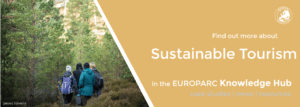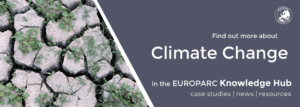New Study: Covid-19 and its impact on Europe’s Protected Areas
Overcrowding in Krkonose NP, photo by Jakub Kaspar
A new study by the FIDELIO research project in which the EUROPARC Federation contributed, analyses the impact of COVID-19 on Protected Area management and its policy implications.
New challenges for European Protected Areas
As many countries imposed lockdowns during the spring and autumn COVID waves, Parks management authorities also had to come up with new safety measures. Analysing the experiences of 14 European Protected Areas during the coronavirus pandemic, the study ‘The Impact of COVID-19 on the Management of European Protected Areas and Policy Implications‘, which was recently published in the Forests journal, identifies the biggest challenges for Europe’s parks.
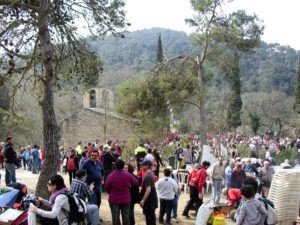
Event at the Consorci Parc, Collserola
Overcrowding, new profile of visitors, problematic behavior, and conflicts between different user groups are among the most important ones. The irresponsible behaviour of newly attracted nature visitors in combination with their record-breaking numbers put unexpected pressure on the parks and their staff, naturally generating pleas for more support.
Read ‘The Impact of COVID-19 on the Management of European Protected Areas and Policy Implications‘ here!
Response of the Parks
The researchers identified some of the most effective responses to these challenges, including information campaigns, traffic management, and establishing one-way systems on trail paths.
At the same time, the study notes that these measures might be in conflict with other management measures aiming to protect wildlife and ecosystems from tourism-related disturbances.
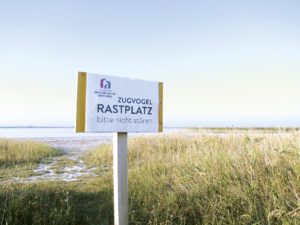
Foto NP Neusiedler See, B. Masin
Lessons for PA management
That is why the researchers also highlight three areas in which management of Protected Areas can learn from the experience of this pandemic. These three areas are:
- managing visitor numbers in order to avoid overcrowding through careful spatial planning,
- introducing educational campaigns, particularly targeting a new profile of visitors,
- promoting sustainable tourism models, which do not rely on large visitor numbers.
Even though the covid-19 poses new challenges, it can also be seen as an opportunity to promote new and more sustainable ways to manage our protected landscapes.
About the FIDELIO project
FIDELIO (Forecasting Social Impacts of Biodiversity Conservation Policies in Europe) is a 5 year project carried out by researchers at the University of Cambridge, funded by the European Research Council. The project focuses on the effectivity of Protected Areas management – exploring complexities in their socio-ecological systems and the important role of social impacts of conservation policies. With the COVID-19 pandemic, the focus of the project shifted towards investigating the impacts of the coronavirus situation on Protected Areas.
EUROPARC was proud to take part in the research, particularly in connecting the researchers with relevant park authorities, and in facilitating workshops where the impacts, challenges, reactions and policy implications were discussed.
EUROPARC TransParcNet Meeting 2020 – online!
Due to COVID, a face to face TransParcNet meeting was not possible. However, crossborder cooperation stops for nothing – this is why EUROPARC decided to move the meeting online. Fittingly, the theme was “Crossborder cooperation in COVID Time”
On the 9th of December, 54 participants from 18 countries met online for the TransParcNet meeting 2020. TransParcNet is the annual internal event of Transboundary Protected Areas network certified by EUROPARC, in the framework of the Transboundary Parks Program “Nature has no borders”.
Of course the theme this year was: “Cross border cooperation in COVID time”.
The event was facilitated by Stefania Petrosillo, EUROPARC’s policy officer and person in charge of the Transboundary Parks Program, with the support of Lisanne Kruiswijk, policy assistant, and Fernando Pinillos, communication and IT officer. You can find the agenda here.
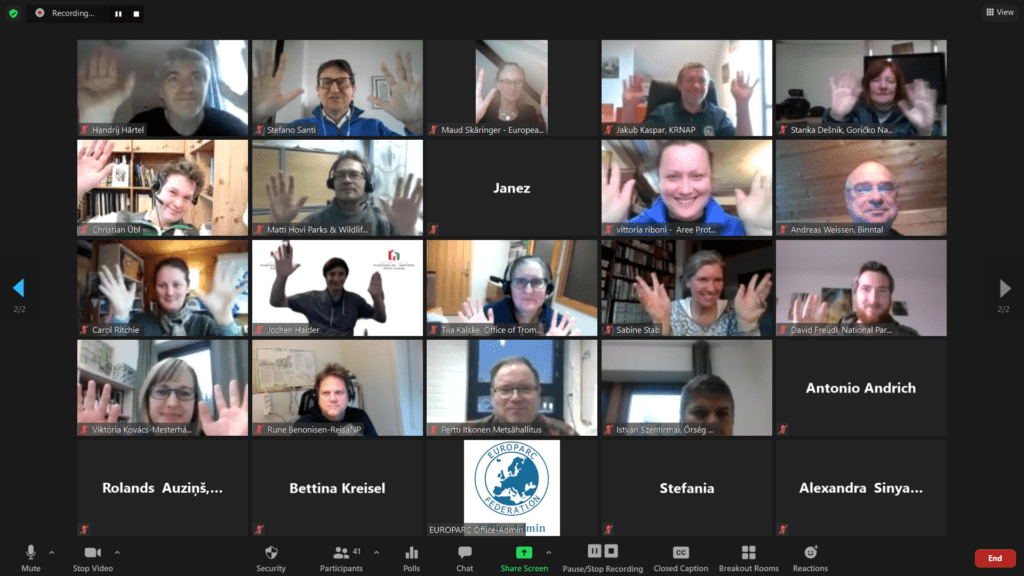
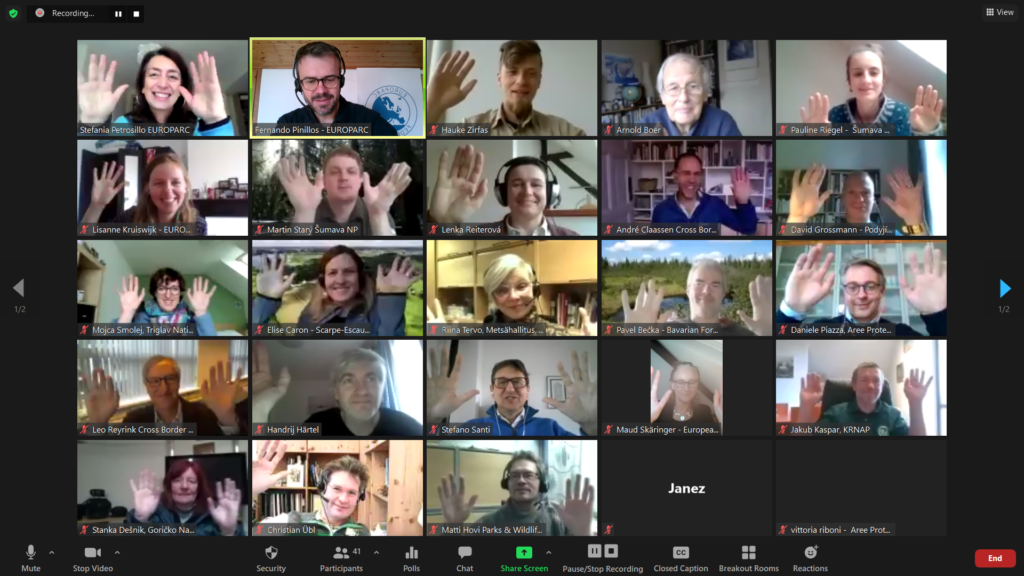
The TransParcNet Family
We heard from…
EUROPARC’s president Ignace Schops, as he said some inspiring words to open the day.
Riina Tervo, chairwoman of the Transboundary Task Force. She shared the results of the work of the networks and of the Transboundary Areas in the past year. Despite all difficulties, they successfully managed projects, common initiatives and the management of crisis and adverse events.
The European Commission, represented by Mr Maud Skaringer from DG REGIO and Mr Przemyslaw Oginski from DG ENV. They provided updated information about the EU Cohesion Policy/Interreg program, as well as on the cross border component in the EU Biodiversity Strategy 2030. We were very happy to welcome the Commission as it increased once more the dialogue, promoted by EUROPARC, between the European Institutions and the Parks, who are key implementing actors on the field of the European policies.
Mr Boris Erg, from the IUCN-WCPA Transboundary Specialist Group. He illustrated the instruments and publications IUCN makes available to help conservationist to improve their capacity with regards to cross-border collaboration. His participation was a good opportunity for exchange of ideas about possible future synergies with IUCN on this topic.
A new member
We are excited to see that the TransParcNet family is growing. During the event the Moor-Veerland International Nature Park (DE-NL) received the good news that its candidature has been approved by the EUROPARC Council: WELCOME!
In the upcoming days the other new candidate HALTI Area (located in Käsivarsi Wilderness Area, Finland and Reisa National Park and Ráisduottarháldi Landscape Protectead Area, Norway) and the candidatures that are up for renewal (Julian Alps IT/SI, and Sumava-Bavarian Forest Parks DE/CZ) will receive the answers of the results of their evaluation processes, which is currently still ongoing.
For this special occasion, the Julian Alps showed us their beautiful film “Nature without Borders”, which was produced in the framework of an Interreg project. It made all participants dream and eager to return to travel as soon as possible! You can watch the trailer here:
Note: The film Nature without Borders can be seen at Dom Trenta, Triglav National Park and the Transboundary Ecoregion Julian Alps Info Center.
Workshops
After a nice informal lunch together online, the participants broke up in two working groups.
The WORKSHOP 1 “COVID time and transboundary cooperation” was led by Mr Daniele Piazza and Mr Jakub Kašpar, members of the network. They shared experiences, impressions, challenges and suggestions for the future.
The WORKSHOP 2 “New projects for the network”, facilitated by two other members of the network, Mr Stefano Santi and Mr Leo Reyrink, explored priorities and possibilities for new projects in order to reinforce and increase the network.
The event was closed by the Director of the EUROPARC Federation Mrs Carol Ritchie, who thanked the participants not only for their presence at the event, but above all by their daily commitment for the underlying values of the EUROPARC Transboundary Parks Program: nature, dialogue and peace.

Want to learn more about Transboundary cooperation, click on the image to go to our Knowledge Hub to find practical examples.
IUCN report: Climate change is the top threat to natural World Heritage
IUCN World Heritage Outlook 3
According to the new report “IUCN World Heritage Outlook 3“, climate change now represents the biggest danger to natural World Heritage sites – threatening a third (33%) of these sites.
Climate change threatening the World Heritage
Building on previous reports from 2014 and 2017, the IUCN World Heritage Outlook 3 tracks the improvements or worsening of conservation in the world’s 252 natural World Heritage sites. It then classifies the individual sites according to whether their conservation is sufficient to protect them in the long term. Additionally, the report identifies the biggest threats.
In the new report, climate change has overtaken invasive species as the top threat to natural World Heritage.
From shrinking glaciers to coral bleaching to increasingly frequent and severe fires and droughts, climate change is affecting the world’s most precious and irreplaceable places. Among the 83 natural World Heritage sites seriously threatened by climate change is for example the Great Barrier Reef in Australia, where ocean warming, acidification and extreme weather contribute to dramatic coral decline.
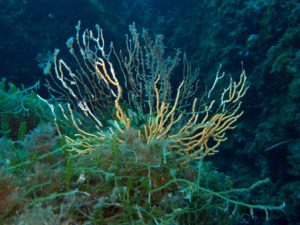
Mortality events on Gorgonian corals. Photo: Lorenzo Merotto
While the international community sets new objectives to conserve biodiversity and fight climate change, the report signals the urgency to address the environmental challenges NOW and at the global scale.
Download the IUCN World Heritage Outlook here
One of the gloomiest figures resulting from the report concerns the quality of protection and management. The Outlook finds that 16 natural World Heritage sites have deteriorated since 2017, while only eight have improved.
How is Europe doing?
The report found the following about the conservation in the 54 natural and mixed World Heritage sites in Europe:
- for one-third (33.5%) the conservation outlook is “good”,
- for just over one-third (35%) the conservation outlook is “good with some concerns”,
- for just under one-third (31.5% ) the conservation outlook is assessed as “significant concern”,
- there are no sites in Europe for which the conservation outlook is assessed as “critical”.
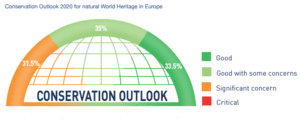
Source: IUCN World Heritage Outlook 3, page 60
As for the threats, the most prevalent threat to European World Heritage sites is currently climate change, followed by invasive species and impacts from tourism and visitation.
On the brighter side, the Outlook found an improvement compared to 2017, with the percentage of European sites assessed as having highly or mostly effective protection and management increasing from 49% to 54%.
Hope for the future
The findings of the report point to one clear conclusion: there is an urgent need for adequate resources to manage the most precious places on our planet, if we want to protect them efficiently and preserve them for the future generations.
Some of the sites that managed to improve their conservation score over time, represent great hope for the future. Peter Shadie, the Director of IUCN’s World Heritage Programme, said:
Many natural World Heritage sites show that conservation can and does work for the greater good, and their achievements serve as models that can be replicated and scaled up elsewhere.
With climate change posing such a great threat to our natural heritage, EUROPARC is happy to be part of the ambitious project “Natur’Adapt”. Natur’Adapt aims at triggering a transition towards the adaptive management of Protected Areas while laying the foundations of a dynamic collective learning process.
Visit the new section on climate change on our website, read about the Natur’Adapt project and discover more inspiring resources on the topic!
